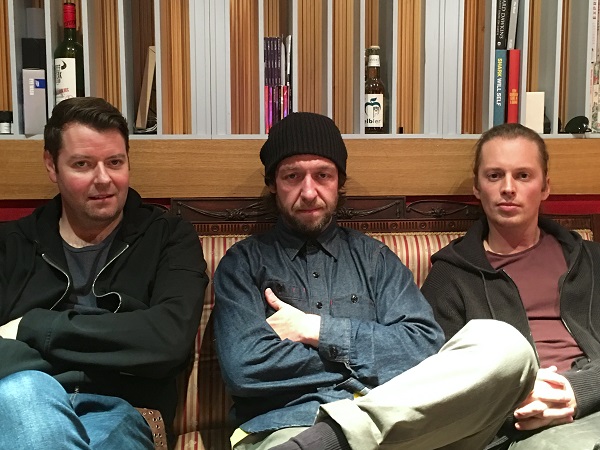
Philip Jewson, Alex Beitzke, and Bradley Spencer on Bringing James Arthur Back From The Edge

Former X Factor winner James Arthur has been catapulted back into the spotlight by the triumphant new album, Back From the Edge, which has won James his first albums chart crown after successfully fighting off competition from Elvis Presley, Michael Bublé and Daft Punk. The lead single, Say You Won’t Let Go, has sold more than 700,000 copies and sat at #1 on the Official Charts for an impressive three consecutive weeks.
James worked closely with an incredible team based in the renowned Dean Street Studios, which has seen half a century of music royalty walk through its doors. He was in the capable hands of Yellow Boat Music’s Creative Director and Composer, Philip Jewson, and experienced freelance producers Bradley Spence and Alex Beitzke, who, between them, have delivered projects for legends such as Burt Bacharach, Jamiroquai, Take That, and Florence + the Machine to name a few. The three share how they crafted James’ vehicle for redemption, and how they managed to pull off this epic creative and commercial success.
LBB> What was the aim in terms of the sound for this new album? With the theme of redemption playing such a key role, how did this translate musically?
Bradley Spence> I don’t think anything was overly discussed but redemption was definitely at the forefront of our minds. More than anything, we wanted to give all the tracks some class and personality.
Philip Jewson> I think this comes through in the stripped-back aspect of the album. We didn’t want it to sound too sanitised or nitpick-y. It just stays in its raw, natural form.
Alex Beitzke> One of the ideas we had for this album was to create a tougher sound without dominating it with electric guitars - which James loves because he comes from a rock background. We used brass like saxophone and trumpet to give it weight; Phil came up with this recurring saxophone motif that we ended up using throughout the album and it became a reference point for James too. The central role of the brass was something we spoke about early on and I think it’s one of the key elements of the album as it gives it that edge.
BS> James’ voice is so good that it ties everything together; you can almost put any amount of cacophony under him and it’ll just work. It helps to mentally visualise the music video of the track and then build up the sounds from there, so you’re creating scenes. For the percussion on the track, Prisoner, for example, we created a menacing feel by using the literal sounds of slamming doors and chains.

From Left: Philip Jewson, Bradley Spence, and Alex Beitzke
LBB> Back From the Edge has completed James’ incredible comeback by scoring him his first #1 on the Official Albums Chart. Did you think it would be this successful?
BS> No. That’s not because we didn’t have faith in the album but because it’s so incredibly difficult to crack the top 10, which is dominated by the likes of Justin Bieber. To have got #1 for multiple weeks is just amazing.
AB> We knew this was definitely something special. When we started discussing the story behind each song, we realised that it was so much more meaningful. Because there wasn’t that expectation for the album to be this massive, it gave us space to experiment without second-guessing whether it was going to be judged by this criteria. I was just jamming with the acoustic guitar, for example, and we tried to re-record it but it just didn’t fit as well as the rough mix did.
PJ> When you overthink it, you sometimes end up losing the character.
LBB> What was it like working with James Arthur?
PJ> It was the first time any of us had worked with James. The two things that immediately stood out for me was a) what a nice guy he is, and b) what an unbelievably good singer he is. He was so on it all the time.
BS> Most of the time, you’re trying to create a story with an album but, with James, his angle’s there for all to see. Everyone likes an underdog story and he was exactly that. He’s just a regular guy. He didn’t enter X Factor with the expectations of winning but he ended up becoming a star and getting put through the ‘celebrity’ mill a bit. He’s a great singer with a solid fan-base, and he deserves this success.
AB> James is a lovely person and incredibly dedicated. It’s impossible to get anything bad out of him. He has perfect memory of every take he does, to the point where he’d sometimes be so precise even we didn’t hear it! We’d be compiling different vocal takes and he’d say, “We need this word from take 37 and the second sound of this first word needs to be the take before.”
LBB> How long did the album take to complete?
PJ> We had three months to create a 17-song album. It was a pretty quick turnaround considering we had so much to do - essentially, building the songs from zero.
BS> Booking studios and trying to get a band and musicians in such a short period of time is quite difficult but it was an enjoyable challenge.
AB> To be honest, it was a really fun project.
BS> There were no real clashes either. A&R had strong views on Safe Inside when it presented itself to be the single, but otherwise, they were happy for us to have total control over the rest of the album.
BS> If you’ve got too much time, you’ll just keep adding stuff.
PJ> A good deadline definitely helps because everyone’s focused and you have to make a decision rather than coming up with endless options.
LBB> How closely did you all work together?
BS> Alex and I handled the production, recording, and mixing.
PJ> These guys [Alex and Brad] gave me tracks in several different stages and they’d either have a distinct idea of what they wanted or just give me free reign. I put a few little bits down and we just built it out from there really. I also played guitar and sax on some of the tracks.
AB> Safe Inside is a good example. When we handed it over to Phil, there wasn’t even any drum programming so he basically started from scratch with just a vocal. We had an idea that required a certain kind of sonic feel. You can’t just have a random organ sound because that’s not going to do it. It’s got big sections and build ups. Instead of making it a ballad-y halftime anthem, we wanted to give it a kind of optimistic feel because it’s a sad story but it’s still lifting you up with that energy.
PJ> We were building a soundscape for that particular one that felt credible and did his voice justice because, even though it’s moving and pulsating underneath, it’s still about him at the heart. That was generally the case for most of the songs.
LBB> How is the music style of this new album different compared to James’ early work?
BS> It’s edgier and more mature.
AB> I like the review that called it ‘the anti-X Factor’ album.
BS> James is getting a lot of stuff off his chest. It’s definitely from the heart. On his first album, he did the vocals but he wasn’t given much control otherwise. We didn’t want to do that. It seems like quite a foreign way to work with an artist. You want them to like it because they’ve got to go out and sell it. So James was in here all the time, which suited us really well.
AB> James was quite conscious of not making it sound too American because he’s a Yorkshire guy. I think it was about reflecting his true self better.
LBB> Have you guys collaborated before? What was this experience like?
PJ> We’ve been collaborating on and off for maybe the past two years. The first thing I worked with Brad on was for The Strypes, which I did some arranging on. Then we also worked on Take That together.
AB> We initially worked on Sarah and Julian as well, who are signed to PIAS Germany.
PJ> It was nice to balance out the commercial work with a longform project like this. We’ve known each other for a while now and we all hang out as mates anyway, so it’s nice to collaborate professionally. We know each other well enough to be direct and when the heat is on, you can’t be treading on eggshells.
When you think you’ve only got one chance to get it right, you end up going for the safe side of things. But when you’re working with people face to face like this, you don’t mind going a bit crazy and saying, “Look, I don’t know how this is going to turn out but let’s go for it and see what happens!” That often gets better results because you’re more likely to create something a bit wackier.
BS> I know that, for some, music is a singular vision in a darkened bedroom, but most of the time, I think collaboration is beneficial in music.
PJ> We all have our own creative methods. I find it fascinating seeing how different people work. I’ll do a part but these guys might not necessarily use the whole thing or it might be that they’ve used it in a slightly different way to how I first conceived it.
AB> Everyone can get precious about their creations because a lot of work goes into making something crisp. But when that gets handed over to us, we can rip the topping off and make it sound weird and dark and lo-fi, because we’re not attached to it. It might just end up working better in the track.
PJ> That’s why you need more than one person involved. One person will spend two hours making something, thinking ‘that’s it’ but sometimes you need someone else to fuck it up a bit.
AB> It takes a lot of mental strength to ruthlessly destroy your darlings. It’s really painful. Some people are good at that but it’s a lot easier if someone else does it.
LBB> What’s the culture like in Dean Street Studios?
PJ> It’s a really nice creative community. There’s a lot of cross-pollination. Being in the same place just makes everything so easy.
BS> Everyone in this building would help everyone out, and not for the money.
AB> It’s so easy to collaborate. Sometimes, there’s a door open and you hear something and think, ‘Wow, that sounds crazy! I’m going to go in and find out what’s going on’.
BS> As soon as anyone gets a new toy, everyone wants to try it out.
AB> It’s always been like that but I think, definitely in the last year, everything’s grown in a nice direction. We work with Studio 1 for any recordings we might need.
PJ> We’ve been working more with Charlie [Russell] in Studio 5, who we worked on Take That with.
BS> And for sound effects, we work with Guilt Free Post in Studio 3. Sometimes we get a really obscure brief and they have this massive library that’s perfect for that. We used it for James’ album too. I once worked on a song where the brief was to create a sound that reflects a car crash and a rowdy bar and strip-club in the desert. It actually turned out pretty cool but initially, I was trying to work out how on earth I was going to pull that off because deserts don’t make a huge amount of sound. So that was a Guilt Free moment.
LBB> Phil, recently you also worked on a project for Burt Bacharach. How did this come about and what was it like working with such a musical legend?
PJ> Danton Supple, who did Coldplay’s XY album, was a producer down here and he was always saying that it’d be great to do something together. I did some string arranging for him on a project, then around last Christmas, he said he had this new artist, Norma Jean Martine who’s co-written a song with Burt Bacharach, and asked me whether I’d like to play the piano on it. Obviously, I said I’d love to, so they sent a video of Burt and Norma rehearsing together as an example of the feeling they were going for.
We set up a microphone and piano and Norma and I just played it over a few times. She’s a lovely girl and a very talented singer; she was spot on every time so the whole process was fairly quick. Burt gave it a thumbs-up and that album’s been really well received. It was a huge privilege because it’s not every day that you get to work on a Burt Bacharach song; that’s one to tell the grandkids one day!
LBB> What are you working on at the moment?
PJ> We’ve working on a project for a Japanese psychedelic pop band called The fin.
BS> Phil’s bringing a bit of Daft Punk to the proceedings!
BS> They’ve come over from Japan to do an album with us for three months.
PJ> It’s great fun, and a different outlet for me personally too.
BS> It’s always fun just getting new bits from people.
AB> It’s like unwrapping presents.
BS> Then you throw it in the track and hit play and enjoy.









